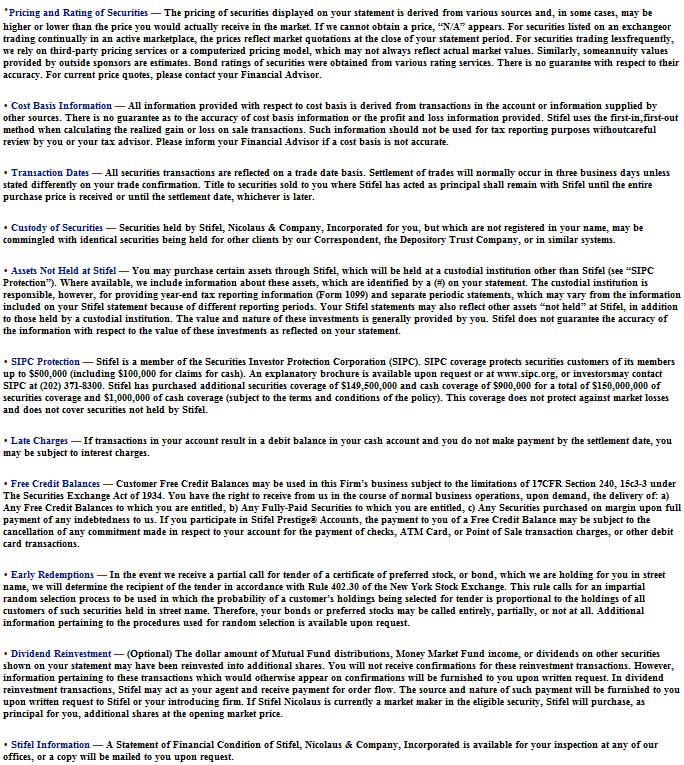|
ROLLOVER
CENTER |
| |
|
| |
STIFEL NICOLAUS |
| |
|
|
Investment StrategistTM
New Year,
New Retirement Plan Limits
February 2008
|
With the
new year come several important changes to retirement plan
contribution guidelines that can potentially have a significant
impact your retirement savings. While contribution limits for some
retirement vehicles, such as 401K plans, remain unchanged from
2007, if you�re looking to maximize the value of your nest egg,
you�ll want to pay close attention to the new guidelines listed
below. |
 |
IRA
Contribution Limits
For years,
the maximum IRA contribution was stuck at $2,000 per year before the
government increased the limit (in 2002, 2005, and 2008) and then will
begin indexing it for inflation in 2009. For tax year 2008 and beyond,
the contribution limits for traditional and Roth IRAs have been
increased from $4,000 to $5,000. Individuals age 50 andover can
contribute an additional $1,000 (also known as �catch-up�
contributions) for a total of $6,000 per year. The $1,000 catch-up
contribution is unchanged from 2007.
Think an
extra $1,000 won�t make much of a difference? Think again. The ability
to contribute an additional $1,000 to your IRA in 2008 can have a
significant impact on your retirement savings, even more so if you
qualify for the catch-up provision. For example, if you contribute
$6,000 per year instead of $5,000 for 15 years and earn an average
annual return of 8%, you�ll end up with $163,000 instead of $136,000 �
a difference of $27,000!
Traditional
IRA Deductibility
The limits
for the deduction of traditional IRA contributions have increased as
well in 2008. Traditional IRA contributions are fully tax deductible
unless an individual is an �active participant� in an
employer-sponsored retirement plan (such as a 401K). If the
individual is an active participant, the deductibility of traditional
IRA contributions depends on the adjusted gross income (AGI) of the
IRA holder and his or her spouse, if filing jointly.
The AGI levels for
deductibility by active participants are as follows:
|
Single |
Married Filing Jointly |
|
2007 |
$52,000-$62,000 |
$83,000-$103,000 |
|
2008 |
$53,000-$63,000 |
$85,000-$105,000 |
Single
Filers
For 2008, a
single individual who is an active participant in an
employer-sponsored retirement plan may deduct the full $5,000 if their
AGI is below $53,000. A partial deduction may be taken if his or her
AGI falls between $53,000 and $63,000, and no deduction may be taken
if his or her AGI exceeds $63,000. Individuals age 50 and older who
make catch-up contributions may deduct those additional amounts as
well, provided that their AGI falls within the limits listed above.

V i s i o n
� P l a n n i n g
�
Focus
SNINS060801 |
| |
|
New Year,
New Retirement Plan Limits |
| |
|
Married
Filing Jointly
The status
of each spouse is considered independent. Spouses who actively
participate in employer-sponsored retirement plans may fully deduct
their 2008 IRA contributions if the couple�s joint AGI is below
$85,000. Partial deductions may be taken if the couple�s AGI falls
between $85,000 and $105,000, and no deduction may be taken if their
AGI exceeds $105,000.
If one
spouse is an active participant in an employer-sponsored retirement
plan and the other is not, the spouse that is not an active
participant may make a fully deductible 2008 IRA contribution if the
couple�s AGI is less than$159,000. A partial deduction may be made for
a non-active spouse if the couple�s AGI is between $159,000 and
$169,000.
Roth IRA
Contribution Eligibility
Individuals
are eligible to make after-tax contributions to a Roth IRA, provided
that their AGI falls within the following levels:
| |
|
Single |
Married Filing
Jointly |
|
2007 |
Full Contribution |
Up to $99,000 |
Up to $156,000 |
|
Partial Contribution |
$99,001-$114,000 |
$156,001-$166,000 |
|
2008 |
Full Contribution |
Up to $101,000 |
Up to $159,000 |
|
Partial Contribution |
$101,001-$116,000 |
$159,001-169,000 |
Partial
Contributions
A partial
2008 contribution may be made to a Roth IRA for single individuals
whose AGI is between $101,000 and $116,000. For married couples filing
a joint return, a partial 2008 contribution may be made if their AGIis
between $159,000 and $169,000. Note that married couples filing
separate returns are not eligible for Roth contributions.
Roth IRA
Conversions
In order to
convert a traditional IRA to a Roth, certain requirements must be met:
1) The individual�s AGI must be $100,000 or less, and the same AGI
applies for a married couple filing a joint return.
2) A married couple must file jointly � an individual who files as
�married filing separately� is not eligible for a Roth conversion.
Starting in
2010, thanks to a provision in the Tax Increase Prevention and
Reconciliation Act of 2005, the AGI restrictions on Roth IRA
conversions will be lifted, allowing more people to take advantage of
the Roth�s many benefits. Under this provision, individuals will also
have the ability to spread their tax liability on amounts converted in
2010 evenly over tax years 2011 and 2012. Your tax advisor can provide
you with details. In the meantime, until 2010, the income requirements
listed above must be met in order to successfully convert a
traditional IRA to a Roth. Individuals who do not meet these
requirements but attempt a Roth conversion anyway will have performed
a �failed� or ineligible conversion.
Saver�s Tax
Credit
The saver�s
tax credit, which was made permanent under the Pension Protection Act
of 2006, also has increased limits. The saver�s tax credit is a
non-refundable tax credit for eligible taxpayers who make
contributions to an employer-sponsored retirement plan and/or a
traditional and/or Roth IRA. The credit is for 10 to 50% of eligible
contributions of up to $2,000, so the maximum possible amount of the
credit is $1,000. Since it is a tax credit, it
|
|

reduces the
amount of tax owed, as opposed to tax deductions, which reduce taxable
income. The amount of the credit depends on the filer�s AGI, filing
status, and the amount contributed to a retirement plan.
The new AGI limits for
the saver�s tax credit are:
| Credit Rate |
Married Filing
Jointly |
Head of
Household |
Single/Married
Filing Jointly |
| 50% |
$0-$32,000 |
$0-$24,000 |
$0-$16,000 |
| 20% |
$32,001-$34,500 |
$24,001-$25,875 |
$16,001-$17,250 |
| 10% |
$34,501-$53,000 |
$25,876-$39,750 |
$17,251-$26,500 |
| 0% |
$53,000+ |
$39,750+ |
$26,500+ |
|
What
Else Has Changed?
Other
changes have taken effect this year that impact retirement plans:
� Annual
benefit under a defined benefit plan � increased to $185,000
� Annual
addition/contribution limit under a defined contribution plan or
SEP IRA � increased to $46,000
�
Compensation cap for all deferred compensation plans � increased
to $230,000
Your New
Year�s Resolution: Save More for Retirement!
Make a
resolution to make the most of your retirement savings in 2008 by
taking advantage of the recent changes. Your Stifel
Financial Advisor can provide you with additional details on how
to boost your retirement savings and set you up to have your
contributions automatically transferred from your checking and
savings account on a regular basis � the most convenient way to
maximize your IRA.

|
Summary
of Changes to |
|
IRA
Guidelines for 2008 |
|
2007
2008 |
|
Traditional and Roth IRA Contribution |
|
$4,000
$5,000 |
|
Roth IRA Eligibility Compensation |
|
Married Filing Jointly |
|
100% $156,000 or less
$159,000 or less |
|
Partial $156,001-$166,000
$159,001-$169,000 |
|
None
$166,000+
$169,000 |
|
Single |
|
100%
$99,000 or less
$101,000 or less |
| Partial
$99,001-$114,000 $101,000-$116,000 |
|
None
$114,000+
$116,000+ |
|
IRA Deductibility Compensation |
|
Married Filing Jointly |
|
(and Active) |
|
100%
$83,000 or less
$85,000 or less |
|
Partial
$83,001-$103,000
$85,001-$105,000 |
|
None
$103,000+
$105,000+ |
|
Married Filing Jointly |
|
(Not Active, but spouse is Active) |
|
100%
$156,000 or less
$159,000 or less |
|
Partial
$156,001-$166,000 $159,001-$169,000 |
|
None
$166,000+
$169,000+ |
|
Single |
|
100%
$52,000 or less $53,000
or less |
|
Partial
$52,011-$62,000
$53,001-$63,000 |
|
None
$62,000+
$63,000+ |


 Stifel, Nicolaus & Company, Incorporated
� Member SIPC and New York
Stock Exchange
� One
Financial Plaza, 501 North Broadway, St. Louis, Missouri 63102
� www.stifel.com
|
|
|



